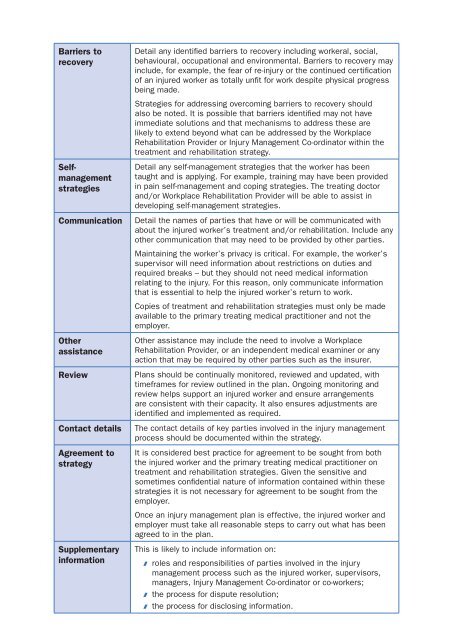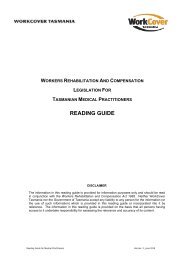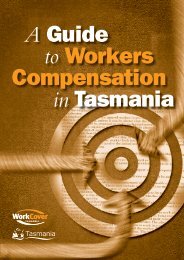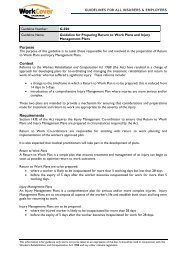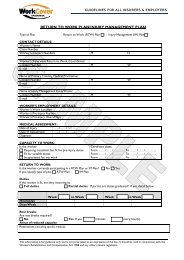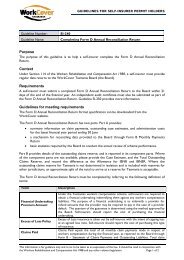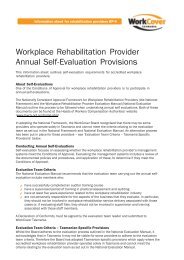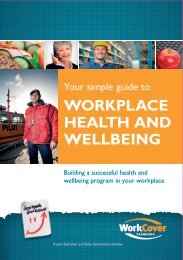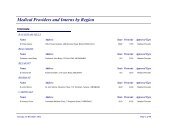Preparing injury management plans - WorkCover Tasmania
Preparing injury management plans - WorkCover Tasmania
Preparing injury management plans - WorkCover Tasmania
Create successful ePaper yourself
Turn your PDF publications into a flip-book with our unique Google optimized e-Paper software.
Barriers torecoverySelf<strong>management</strong>strategiesCommunicationOtherassistanceReviewContact detailsAgreement tostrategySupplementaryinformationDetail any identified barriers to recovery including workeral, social,behavioural, occupational and environmental. Barriers to recovery mayinclude, for example, the fear of re-<strong>injury</strong> or the continued certificationof an injured worker as totally unfit for work despite physical progressbeing made.Strategies for addressing overcoming barriers to recovery shouldalso be noted. It is possible that barriers identified may not haveimmediate solutions and that mechanisms to address these arelikely to extend beyond what can be addressed by the WorkplaceRehabilitation Provider or Injury Management Co-ordinator within thetreatment and rehabilitation strategy.Detail any self-<strong>management</strong> strategies that the worker has beentaught and is applying. For example, training may have been providedin pain self-<strong>management</strong> and coping strategies. The treating doctorand/or Workplace Rehabilitation Provider will be able to assist indeveloping self-<strong>management</strong> strategies.Detail the names of parties that have or will be communicated withabout the injured worker’s treatment and/or rehabilitation. Include anyother communication that may need to be provided by other parties.Maintaining the worker’s privacy is critical. For example, the worker’ssupervisor will need information about restrictions on duties andrequired breaks – but they should not need medical informationrelating to the <strong>injury</strong>. For this reason, only communicate informationthat is essential to help the injured worker’s return to work.Copies of treatment and rehabilitation strategies must only be madeavailable to the primary treating medical practitioner and not theemployer.Other assistance may include the need to involve a WorkplaceRehabilitation Provider, or an independent medical examiner or anyaction that may be required by other parties such as the insurer.Plans should be continually monitored, reviewed and updated, withtimeframes for review outlined in the plan. Ongoing monitoring andreview helps support an injured worker and ensure arrangementsare consistent with their capacity. It also ensures adjustments areidentified and implemented as required.The contact details of key parties involved in the <strong>injury</strong> <strong>management</strong>process should be documented within the strategy.It is considered best practice for agreement to be sought from boththe injured worker and the primary treating medical practitioner ontreatment and rehabilitation strategies. Given the sensitive andsometimes confidential nature of information contained within thesestrategies it is not necessary for agreement to be sought from theemployer.Once an <strong>injury</strong> <strong>management</strong> plan is effective, the injured worker andemployer must take all reasonable steps to carry out what has beenagreed to in the plan.This is likely to include information on:AAroles and responsibilities of parties involved in the <strong>injury</strong><strong>management</strong> process such as the injured worker, supervisors,managers, Injury Management Co-ordinator or co-workers;AAthe process for dispute resolution;AAthe process for disclosing information.


